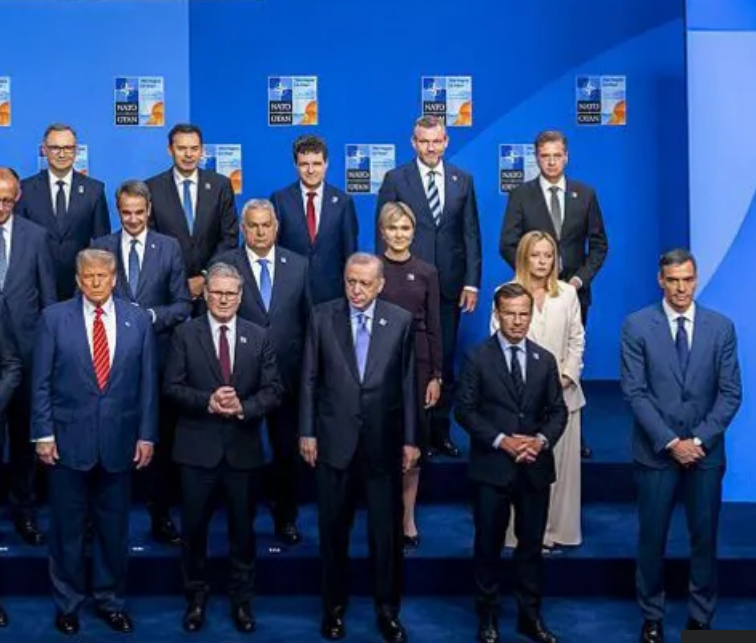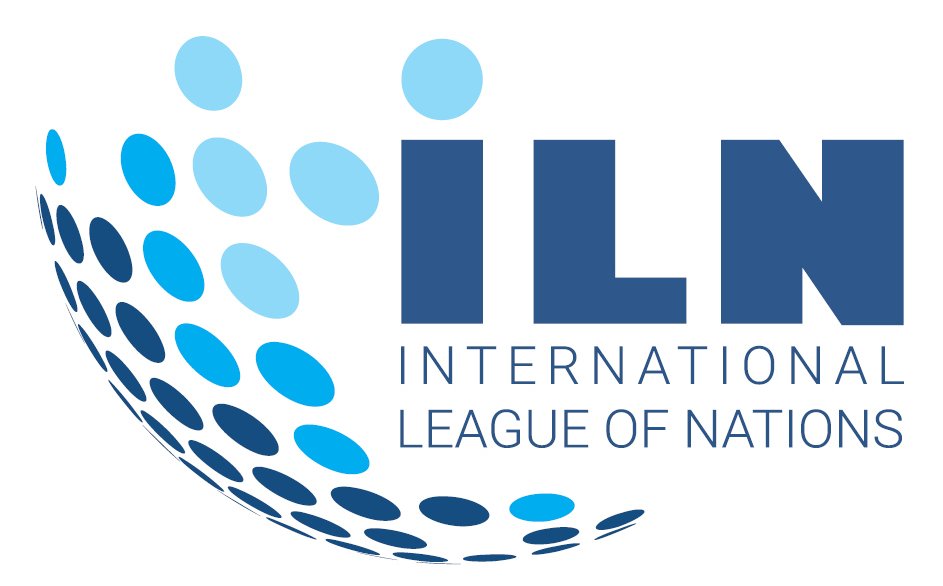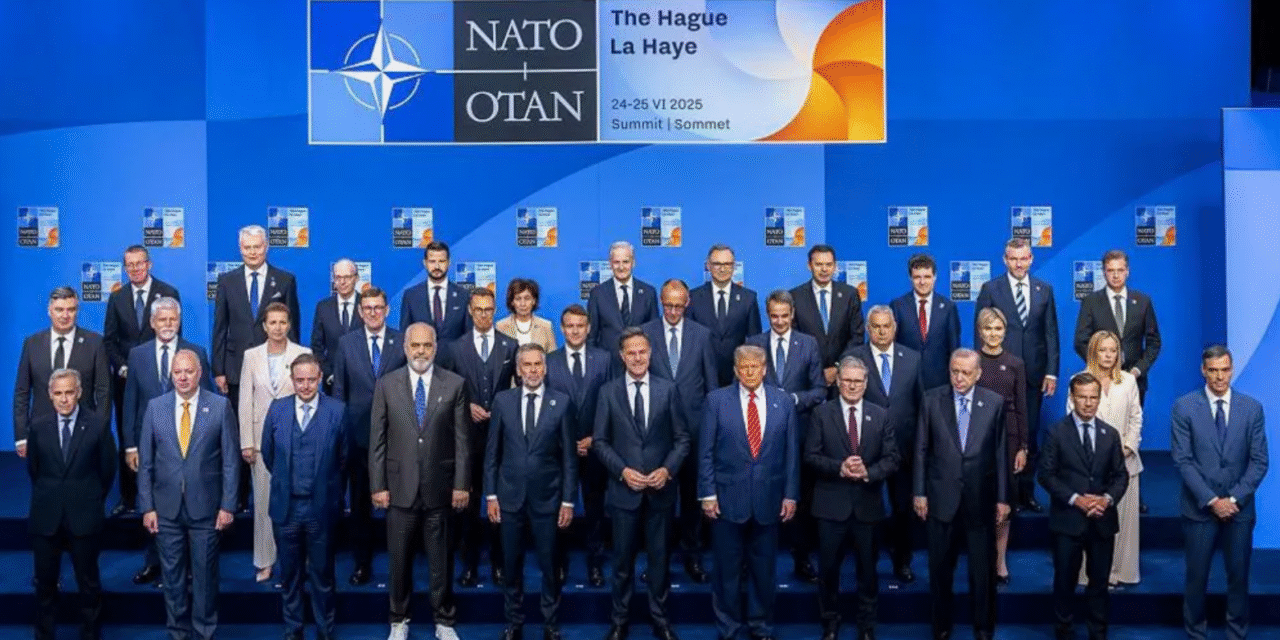The Historic Spending Surge On June 25, 2025, NATO announced a historic decision: by 2035, each member state will be expected to allocate 5% of its Gross Domestic Product (GDP) toward defence and security-related expenditures. This marks a massive escalation from the alliance’s previous 2% target and represents a fundamental restructuring of global defence economics. While framed as a collective security response to global threats, a deeper analysis reveals that this decision disproportionately benefits one actor above all: the United States.
This exposé argues that NATO’s decision is less a unified defence imperative and more a geopolitical economic strategy—a structured wealth transfer akin to ancient imperial tribute systems, funnelling vast sums from member states into the U.S. military-industrial complex.
Total Estimated Spending Increase: $1.49 Trillion per Year. Based on 2024 nominal GDP figures and current defence spending percentages, the total forecasted increase in defence spending across NATO’s 33 members is an astonishing $1.49 trillion annually by 2035.
| # | Country | GDP ($B) | Current % | Current Spend ($B) | 5% Target ($B) | Increase ($B) |
| 1 | United States | 28,720 | 3.37% | 967.86 | 1,436.00 | 468.14 |
| 2 | Germany | 4,610 | 2.12% | 97.73 | 230.50 | 132.77 |
| 3 | United Kingdom | 3,520 | 2.33% | 82.02 | 176.00 | 93.98 |
| 4 | France | 2,610 | 2.06% | 53.77 | 130.50 | 76.73 |
| 5 | Italy | 2,010 | 1.49% | 29.95 | 100.50 | 70.55 |
| 6 | Canada | 1,820 | 1.37% | 24.93 | 91.00 | 66.07 |
| 7 | Spain | 1,350 | 1.28% | 17.28 | 67.50 | 50.22 |
| 8 | Turkey | 1,290 | 1.31% | 16.90 | 64.50 | 47.60 |
| 9 | Netherlands | 772 | 2.05% | 15.83 | 38.60 | 22.77 |
| 10 | Sweden | 627 | 2.14% | 13.42 | 31.35 | 17.93 |
| 11 | Belgium | 484 | 1.30% | 6.29 | 24.20 | 17.91 |
| 12 | Denmark | 455 | 1.65% | 7.51 | 22.75 | 15.24 |
| 13 | Norway | 500 | 2.20% | 11.00 | 25.00 | 14.00 |
| 14 | Czech Republic | 357 | 1.52% | 5.43 | 17.85 | 12.42 |
| 15 | Portugal | 296 | 1.48% | 4.38 | 14.80 | 10.42 |
| 16 | Romania | 350 | 2.50% | 8.75 | 17.50 | 8.75 |
| 17 | Hungary | 226 | 1.32% | 2.98 | 11.30 | 8.32 |
| 18 | Finland | 303 | 2.41% | 7.30 | 15.15 | 7.85 |
| 19 | Poland | 849 | 4.12% | 34.98 | 42.45 | 7.47 |
| 20 | Greece | 249 | 3.08% | 7.67 | 12.45 | 4.78 |
| 21 | Slovakia | 142 | 1.74% | 2.47 | 7.10 | 4.63 |
| 22 | Luxembourg | 87 | 0.72% | 0.63 | 4.35 | 3.72 |
| 23 | Slovenia | 79 | 1.28% | 1.01 | 3.95 | 2.94 |
| 24 | Bulgaria | 89 | 1.89% | 1.68 | 4.45 | 2.77 |
| 25 | Croatia | 79 | 1.68% | 1.33 | 3.95 | 2.62 |
| 26 | Lithuania | 75 | 2.54% | 1.91 | 3.75 | 1.85 |
| 27 | Iceland | 30 | 0.25% | 0.08 | 1.50 | 1.43 |
| 28 | Latvia | 44 | 2.10% | 0.92 | 2.20 | 1.28 |
| 29 | Bosnia & Herzegovina | 24 | 1.00% | 0.24 | 1.20 | 0.96 |
| 30 | Albania | 23 | 1.85% | 0.43 | 1.15 | 0.72 |
| 31 | North Macedonia | 15 | 1.48% | 0.22 | 0.75 | 0.53 |
| 32 | Estonia | 22 | 3.43% | 0.75 | 1.10 | 0.35 |
| 33 | Montenegro | 7 | 2.00% | 0.14 | 0.35 | 0.21 |
This table highlights the sheer financial magnitude of the policy. Major economies like Germany, the U.K., and France are expected to contribute over $300 billion combined in new annual spending. Even smaller nations such as Portugal, Croatia, and Bulgaria are being compelled to more than double their defence budgets—often with no clear national security benefit, but rather to maintain alignment within NATO’s evolving economic order.
A Hidden Tax on the People. What governments are not telling their citizens is that this increase is not coming from nowhere—it will be paid for through increased national debt, tax hikes, or cuts to essential public services. In almost every NATO country, this mandate will come at the expense of education, healthcare, social services, and green infrastructure. The U.S. is pushing this agenda while its own taxpayers will see only partial returns, as the domestic burden will be offset by the massive influx of foreign funds, particularly from Europe.
Spain’s Refusal and the Summit’s Cold Shoulder

Spain, notably, refused to commit to the full 5% GDP defence spending target. Instead, it successfully lobbied to weaken the summit’s language from “All allies commit” to “Allies agree to work toward” the 5% objective. Spain intends to cap its defence spending at around 2.1% of GDP, just slightly above the original NATO benchmark. Spain’s justification was threefold:
Budget constraints are due to rising domestic costs in pensions, healthcare, and energy subsidies.
Public opposition to redirecting resources from social spending to militarisation.
A commitment to European strategic autonomy, resisting dependency on U.S. military systems.
The Spanish prime minister (far right) is left standing alone in the NATO “family photo”
Yet in retaliation—or perhaps as a subtle form of coercive diplomacy—Spain was excluded from the prominent closing photo-op of the NATO leaders, an unmistakable act of marginalisation that sent a clear message: comply or be sidelined.
Where Will the Money Go? European and non-U.S. NATO countries will be unable to produce enough of their own arms to meet this new threshold. Historically, 60–70% of their high-end defence imports come from the United States. If we assume that even a conservative 50% of the $1.02 trillion non-U.S. spending increase goes to American defence firms, that equates to:
$510 billion/year funnelled directly into the U.S. defence economy.
At a 70% share, the U.S. would take $714 billion annually—a figure greater than the total GDP of countries like Poland or the Netherlands.
Breakdown of U.S. Manufacturer Gains ($510B Estimate):
| Sector | Share of U.S. Export Market | Value (USD) |
| Fighter Jets, UAVs | 25% | $127 billion |
| Missiles & Air Defence | 20% | $102 billion |
| Naval Systems | 10% | $51 billion |
| Cyber & ISR Systems | 15% | $76 billion |
| Maintenance & Training | 10% | $51 billion |
| Armoured Vehicles | 10% | $51 billion |
| Logistics & Comms | 10% | $51 billion |
Top U.S. Corporate Beneficiaries:
- Lockheed Martin
- Raytheon Technologies
- Northrop Grumman
- Boeing Defence
- General Dynamics
These companies are experiencing soaring stock prices and growing political clout. Meanwhile, European manufacturers struggle to compete or are pressured into joint contracts dominated by American designs.
Empire Economics: The Roman Analogy. This situation is strikingly reminiscent of the Roman Empire’s tributary system. In antiquity, Rome demanded gold, slaves, and goods from its provinces. In the 21st century, the U.S. demands procurement contracts, training programs, and system integration.
- NATO states = tributary provinces
- The U.S. = imperial core
- Military spending = modern tribute
The economic dependency means that smaller nations will:
- Sacrifice domestic welfare budgets
- Adopt U.S. military doctrine and technology
- Align politically with U.S. foreign policy
Case in Point: Germany and the U.K.
- Germany: +$132.8 billion/year in new spending, most of it flowing to U.S. contractors.
- United Kingdom: +$93.9 billion/year increase, also reliant on U.S. interoperability and equipment.
Military Keynesianism and the U.S. Economy. This mandate underwrites the U.S. strategy of military Keynesianism—stimulating the economy through defence spending. It provides jobs, fuels R&D, and boosts GDP, particularly in U.S. swing states. In effect, NATO becomes an instrument of U.S. fiscal expansion, funded by foreign nations.
Conclusion: A Hypocritical and Imperial Agenda The U.S. lectures its allies about sovereignty and democracy while coercing them into an imperial tribute system. Citizens across NATO will bear the costs—through taxes, austerity, or inflation—while the Pentagon and its corporate partners reap the rewards.
Spain’s resistance and the symbolic snub it received illustrate how dissent is treated within this empire. The façade of unity masks a deeply imbalanced economic relationship.
This is not collective security—it is economic imperialism with a military face. And the invoice is already in the mail.





